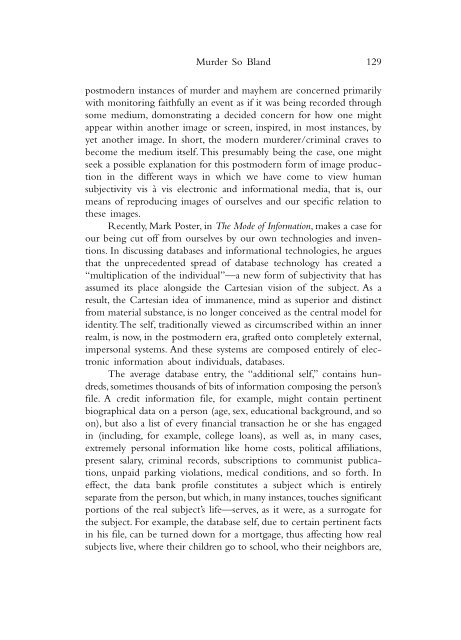You also want an ePaper? Increase the reach of your titles
YUMPU automatically turns print PDFs into web optimized ePapers that Google loves.
Murder So Bland<br />
129<br />
postmodern instances <strong>of</strong> murder and mayhem are concerned primarily<br />
with monitoring faithfully an event as if it was being recorded through<br />
some medium, domonstrating a decided concern for how one might<br />
appear within ano<strong>the</strong>r image or screen, inspired, in most instances, by<br />
yet ano<strong>the</strong>r image. In short, <strong>the</strong> modern murderer/criminal craves to<br />
become <strong>the</strong> medium itself. This presumably being <strong>the</strong> case, one might<br />
seek a possible explanation for this postmodern form <strong>of</strong> image production<br />
in <strong>the</strong> different ways in which we have come to view human<br />
subjectivity vis à vis electronic and informational media, that is, our<br />
means <strong>of</strong> reproducing images <strong>of</strong> ourselves and our specific relation to<br />
<strong>the</strong>se images.<br />
Recently, Mark Poster, in The Mode <strong>of</strong> Information, makes a case for<br />
our being cut <strong>of</strong>f from ourselves by our own technologies and inventions.<br />
In discussing databases and informational technologies, he argues<br />
that <strong>the</strong> unprecedented spread <strong>of</strong> database technology has created a<br />
“multiplication <strong>of</strong> <strong>the</strong> individual”—a new form <strong>of</strong> subjectivity that has<br />
assumed its place alongside <strong>the</strong> Cartesian vision <strong>of</strong> <strong>the</strong> subject. As a<br />
result, <strong>the</strong> Cartesian idea <strong>of</strong> immanence, mind as superior and distinct<br />
from material substance, is no longer conceived as <strong>the</strong> central model for<br />
identity. The self, traditionally viewed as circumscribed within an inner<br />
realm, is now, in <strong>the</strong> postmodern era, grafted onto completely external,<br />
impersonal systems. And <strong>the</strong>se systems are composed entirely <strong>of</strong> electronic<br />
information about individuals, databases.<br />
The average database entry, <strong>the</strong> “additional self,” contains hundreds,<br />
sometimes thousands <strong>of</strong> bits <strong>of</strong> information composing <strong>the</strong> person’s<br />
file. A credit information file, for example, might contain pertinent<br />
biographical data on a person (age, sex, educational background, and so<br />
on), but also a list <strong>of</strong> every financial transaction he or she has engaged<br />
in (including, for example, college loans), as well as, in many cases,<br />
extremely personal information like home costs, political affiliations,<br />
present salary, criminal records, subscriptions to communist publications,<br />
unpaid parking violations, medical conditions, and so forth. In<br />
effect, <strong>the</strong> data bank pr<strong>of</strong>ile constitutes a subject which is entirely<br />
separate from <strong>the</strong> person, but which, in many instances, touches significant<br />
portions <strong>of</strong> <strong>the</strong> real subject’s life—serves, as it were, as a surrogate for<br />
<strong>the</strong> subject. For example, <strong>the</strong> database self, due to certain pertinent facts<br />
in his file, can be turned down for a mortgage, thus affecting how real<br />
subjects live, where <strong>the</strong>ir children go to school, who <strong>the</strong>ir neighbors are,
















